EST – Three Falling Three
Thursday, July 23, 2015
Just months before Esbjörn Svensson died aged just 44 in 2008, EST – the groundbreaking and hugely influential piano trio that Svensson formed with Dan Berglund and Magnus Öström – recorded a great deal of material in a Sydney studio.


Register now to continue reading

Thank you for visiting Jazzwise.co.uk. Sign up for a free account today to enjoy the following benefits:
- Free access to 3 subscriber-only articles per month
- Unlimited access to our news, live reviews and artist pages
- Free email newsletter